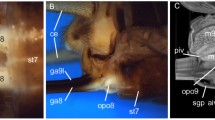Summary
-
1.
The characteristics of a cardioactive peptide(s), LCP, were investigated in the snail,Helix aspersa, to determine if LCP functions as a neurohormone.
-
2.
Fractionation of isotonic homogenates of the auricle and sub-esophageal ganglia indicate that LCP is associated with microsomal elements, probably granules observed in electron micrographs of the microsomal pellets.
-
3.
Ligation experiments carried out under culture conditions suggest that LCP is transported from the sub-esophageal ganglia to the auricle via the visceral nerve. The presence of colchicine in the culture media prevents this transport.
-
4.
LCP is released from the sub-esophageal ganglia and the auricle by incubation in raised K media. This release is largely prevented by lowering the Ca content of the media.
-
5.
LCP is released into the lumen of the auricle by electrical stimulation of the visceral nerve.
-
6.
The ventricle isolated in vitro responds to LCP concentrations similar to those found in the hemolymph. Since the ventricle contains no LCP, this suggests that LCP is carried in the hemolymph from its release site to the ventricle.
-
7.
The combination of these results and those of a preceding paper confirm a role for LCP as a cardioexcitatory neurohormone inHelix.
Similar content being viewed by others
Abbreviations
- LCP:
-
large cardioactive peptide(s)
References
Bern, H.A., Hagadorn, I.R.: Neurosecretion. In: Structure and function of the nervous system of invertebrates. Bullock, T.H., Horridge, G.A. (ed.), Vol. 1, pp. 354–413. London: Freeman 1965
Chapman, G.: In: The body fluids and their functions. London: Arnold 1967
Chooi, W.J., Laird, C.D.: DNA and polyribosome-like structures in lysates of mitochondria ofDrosophila melanogaster. J. Mol. Biol.100, 493–518 (1976)
Cottrell, G.A., Osborne, N.: A neurosecretory system terminating in theHelix heart. Comp. Biochem. Physiol.28, 1455–1459 (1969a)
Cottrell, G.A., Osborne, N.: Localization and mode of action of cardioexcitatory agents in molluscan hearts. Experientia Suppl.15, 220–231 (1969b)
Dale, B.: Blood pressure and its hydraulic functions inHelix pomatia L. J. Exp. Biol.59, 477–490 (1973)
Dale, B.: Extrusion, retraction, and respiratory movements inHelix pomatia in relation to distribution and circulation of the blood. J. Zool. (London)173, 427–439 (1974)
Hiripi, L., Neuhoff, V., Osborne, N.N.: The uptake of biogenic monoamines by the isolated auricle of the snail (Helix pomatia). J. Neurochem.26, 335–343 (1976)
Jones, H.D.: Circulatory pressures inHelix pomatia L. Comp. Biochem. Physiol.39A, 289–295 (1971)
Jones, H.D.: Locomotion. In: Pulmonates. Fretter, V., Peake, J. (ed.), Vol. 1, pp. 1–32. London: Academic Press 1975
Koike, H., Eisenstadt, M.L., Schwartz, J.H.: Axonal transport of newly synthesized acetylcholine in an identified neuron ofAplysia. Brain Res.37, 152–159 (1972)
Liebswar, G., Goldman, J.E., Koester, J., Mayeri, E.: Neural control of circulation inAplysia. III. Neurotransmitters. J. Neurophysiol.38, 767–779 (1975)
Lloyd, P.E.: Distribution and molecular characteristics of cardioactive peptides in the snail,Helix aspersa. J. comp. Physiol.128, 269–276 (1978)
Miller, O.L., Bakken, A.H.: Morphological studies of transcription. In: Karolinska Symposium on Gene Transcription in Reproductive Tissue, Vol. 5, pp. 155–177. Karolinska Institutet, Sweden 1972
Osborne, N.N., Neuhoff, V.: In vitro experiments on the metabolism, accumulation and release of 5-HT in the nervous system of the snailHelix pomatia. J. Neurochem.22, 363–371 (1974)
Ripplinger, J.: Contribution à l'étude de la physiologie du coeur et de son innervation extrinsique chez l'escargot (Helix pomatia). Anuls. scient. Univ. Besancon8, 3–179 (1957)
Rubin, R.: The role of calcium in the release of neurotransmitter substances and hormones. Pharmacol. Rev.22, 389–428 (1970)
S-Rózsa, K., Perényi, L.: Chemical identification of the excitatory substance released inHelix heart during stimulation of the extracardial nerve. Comp. Biochem. Physiol.19, 105–113 (1966)
Author information
Authors and Affiliations
Additional information
I wish to thank Professors L.M. Riddiford, J.W. Truman, and A.O.D. Willows for critical reading of the manuscript. I also wish to thank Gayle K. Lamppa for instructing me in the preparation of samples for, and the use of, the electron microscope. This research was supported by NSF grant BN575 13597 A02.
Rights and permissions
About this article
Cite this article
Lloyd, P.E. Neurohormonal control of cardiac activity in the snail,Helix aspersa . J. Comp. Physiol. 128, 277–283 (1978). https://doi.org/10.1007/BF00656861
Accepted:
Issue Date:
DOI: https://doi.org/10.1007/BF00656861




